The Nagmashot (Nagmasho't) is considered the world's first modern heavy Armored Personnel Carrier (HAPC). In 1982, the IDF command saw its fleet of Sho't Kal main battle tank ageing. These non-fully upgraded Centurions were less useful than a potential conversion into a heavy type, to address the lack of protection of conventional APCs in combat. The Hebrew term for an APC "Nagma" was added to "Sho't" to form its name. Many more will follow, upgraded over time. Their actual numbers within Israel Defense Forces (IDF) is blurry, and it is likely all had been converted to more advanced variants: None is listed today in IDF inventory.
One was very long solution, looking to developed a domestic heavy APC with better protection, or smaller term, a comprehensive upgrade of the M113 (which was done, resulting in the M113A3), or modify existing, but obsolescent main battle tanks, which had the right amount of armour and little modifications needed. The example here were the WW2 "Kangaroo" series. For memory these were improvized armoured personal carriers, made from disabled tanks which lost their turret, but were repaired and in running conditions, just waiting to be mated to a new turret. By the end of the Normandy campaign, there were already scores of such hulls. The Australian and Canadians, which had mixed feeling about existing APCs such as the Bren Carrier or M5 half track, decided to simply put these tank hulls back into service as armoured personal carriers. Ammo lockers were eliminated as well as anything related to the former turret. Troops went in and out from the now open air turret ring, and can fire on the move, well protected. This was better than nothing, and did the job well.
While engaged sometimes against city-blocks transformed as fortesses in the nightmarish war-torn urban context of Beyrouth, it was also specified an heavily-armored vehicle for assaulting well defended strongpoints. But in the end, the overriding factor was that the IDF could not wait for long. It should be improvized and fielded as an interim before the new M113 arrived, and thus, bring ready in the matter of months. Since the concept of the Kangaroo seemed the one that seems to fit the bill, Israeli workshops started work on existing, obsolete tank hulls.
The first choice fell on the wide park of T-54/55 hulls captured after the 1967 and 1973 wars. Many had their turrets non operable, others were just worn out. But there were also many intact hulls of Sho't tanks (upgraded Centurions) without turrets in depots and graveyards. Since engineers had more familiarity with the latter, work started on this base first, and so development of the Nagmasho't was very brief: The first operational heavy APC was thus put into service by 1984 onwards. Fielded immediately and on the frontline, troops enjoyed it so much that its stayed active until the 2000s. However later in the late 1980s the base model was gradually improved, leading to the Nagmachon, which was gradually improved. Meanwhile development on the T-54/55 hulls and former Tiran (IDF westernized version) tanks now obsolete, and imput from the Nagmashot led to design a more radical heavy APC, the Achzarit with a relocated and new engine as well as a new troop compartment. c250 were made after 1988 when accepted into service. They are still fielded now, just as the Nagmashot was replaced by the Nagmachon. The IDF was thus able in the late 1980s to field hundreds of heavy APCs.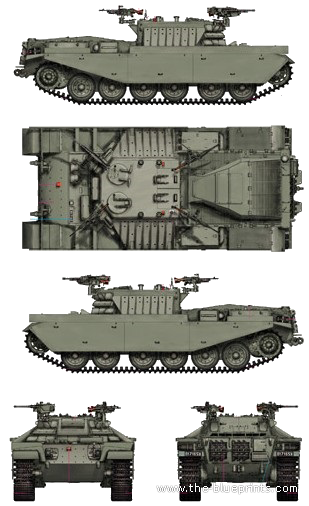
UThe internal compartment, where the turret resided is fitted with seats for 8 infantrymen under the casemate. The driver's position was left unchanged as the rest of the powerplant, dashboard, and transmission through. The driver was not cut from the passengers compartment. The commander rode in front, and there was a radio installed. Entry into and exit was done from the roof hatches. For more safety, the original belly hatch was retained to exit from underneath the vehicle or after a roll-over.
However the Nagmasho't really shines in the arrangement made to receive numerous explosive reactive armor, with up to seven long ERA blocks on either side of the casemate, plus six others of various sizes to fit the surface on each corner, not counting those installed on the glacis nose. The other addition was an add-on belly armor to better shield the crew against mines. In service it seems the vehicles often went without ERA blocks. On the chapter of mines, the original Centurion already had a V-shaped hull offering some residual protection from landmines and IEDs. Loke the original also, the central compartment and engine ones were given Halon type automatic fire suppression systems. It is unlikel however the NBC protection was kept.
No rear door was not ideal for mechanized infantry operations and so these APCs spent only a few years on the frontline. From 1992 most vehicles had been either converted as Nagmachon and Nakpadon vehicles. The last Nagmashot still used by combat engineers were converted in turn into the new PUMA minefield breaching vehicles and only a very few Nagmasho't remained unchanged in depots. One ended at the Latrun Museum where it can be seen today alongside other IDF APCs. The vehicle was never exported, although it was offered for a time, but it was considered by then too tailored for Israeli need, and had issues which made them less attractive propositions than modern APCs.
Origins
The major event leading to the creation of the Nagmasho't was the 1982 Lebanon War. At the time, the IDF still fielded the venerable M3 Half Track, alongside the better protected M113 APC. But when encountering RPG (Rocket Propelled Grenade, Soviet RPG-7 mostly) and ATGM (Anti-Tank Missile) fire with heavy losses, the high command asked itself how to alleviate these with a new kind of (obviously) heavy armoured vehicle. Several tracks were followed.One was very long solution, looking to developed a domestic heavy APC with better protection, or smaller term, a comprehensive upgrade of the M113 (which was done, resulting in the M113A3), or modify existing, but obsolescent main battle tanks, which had the right amount of armour and little modifications needed. The example here were the WW2 "Kangaroo" series. For memory these were improvized armoured personal carriers, made from disabled tanks which lost their turret, but were repaired and in running conditions, just waiting to be mated to a new turret. By the end of the Normandy campaign, there were already scores of such hulls. The Australian and Canadians, which had mixed feeling about existing APCs such as the Bren Carrier or M5 half track, decided to simply put these tank hulls back into service as armoured personal carriers. Ammo lockers were eliminated as well as anything related to the former turret. Troops went in and out from the now open air turret ring, and can fire on the move, well protected. This was better than nothing, and did the job well.
While engaged sometimes against city-blocks transformed as fortesses in the nightmarish war-torn urban context of Beyrouth, it was also specified an heavily-armored vehicle for assaulting well defended strongpoints. But in the end, the overriding factor was that the IDF could not wait for long. It should be improvized and fielded as an interim before the new M113 arrived, and thus, bring ready in the matter of months. Since the concept of the Kangaroo seemed the one that seems to fit the bill, Israeli workshops started work on existing, obsolete tank hulls.
The first choice fell on the wide park of T-54/55 hulls captured after the 1967 and 1973 wars. Many had their turrets non operable, others were just worn out. But there were also many intact hulls of Sho't tanks (upgraded Centurions) without turrets in depots and graveyards. Since engineers had more familiarity with the latter, work started on this base first, and so development of the Nagmasho't was very brief: The first operational heavy APC was thus put into service by 1984 onwards. Fielded immediately and on the frontline, troops enjoyed it so much that its stayed active until the 2000s. However later in the late 1980s the base model was gradually improved, leading to the Nagmachon, which was gradually improved. Meanwhile development on the T-54/55 hulls and former Tiran (IDF westernized version) tanks now obsolete, and imput from the Nagmashot led to design a more radical heavy APC, the Achzarit with a relocated and new engine as well as a new troop compartment. c250 were made after 1988 when accepted into service. They are still fielded now, just as the Nagmashot was replaced by the Nagmachon. The IDF was thus able in the late 1980s to field hundreds of heavy APCs.
Design

Hull and Modifications
Retaning the hull, turretless, the familiar Centurion was a bit more than a Kangaroo with the turret ring still apparent. It was really tailored for the job, with the former turret ring gutted and a large rectangular opening built in place, protected by a pyramidal casemate and rectangular roof. Two circular hatches were placed the front of the casemate roof, hinging to the rear, plus two rectangular hatches aft, hinged in front. This enabled four infantrymen to stand and fire pintle-mounted machine guns at all four angles, for a better coverage in urban combat. This was way before the introduction of small digital cameras. The sides of the casemate had a distinctive flanging usable for additional add-on armor boxes (ERA blocks) defeating RPGs.UThe internal compartment, where the turret resided is fitted with seats for 8 infantrymen under the casemate. The driver's position was left unchanged as the rest of the powerplant, dashboard, and transmission through. The driver was not cut from the passengers compartment. The commander rode in front, and there was a radio installed. Entry into and exit was done from the roof hatches. For more safety, the original belly hatch was retained to exit from underneath the vehicle or after a roll-over.
Protection
The armor of the Nagmasho't was inherited from the Sho't Kal, the earliest variant of the IDF Centurion. Only the casemate was new. Iits armour thickness is kept secret, and thus probably made to resists at least small arms fire, shell splinters or shrapnel, with the double advantage of an heavy slope to artificially increase armour thickness. It is also coated with the same spall liners alredy present in the fighting compartment. The Nagmasho't also kept the track skirts from the original tank for better side protection.However the Nagmasho't really shines in the arrangement made to receive numerous explosive reactive armor, with up to seven long ERA blocks on either side of the casemate, plus six others of various sizes to fit the surface on each corner, not counting those installed on the glacis nose. The other addition was an add-on belly armor to better shield the crew against mines. In service it seems the vehicles often went without ERA blocks. On the chapter of mines, the original Centurion already had a V-shaped hull offering some residual protection from landmines and IEDs. Loke the original also, the central compartment and engine ones were given Halon type automatic fire suppression systems. It is unlikel however the NBC protection was kept.
Powerplant and Performances
The advantage of modifying only the fighting, central compartment in the hull was to leave untouched the powerpack, same as the Sho't Kal. But it rearranged in order to free space for the central compartment. This was the same bulletproof Continental AVDS-1790-2A diesel V12 rated for 750 hp at 2400 rpm coupled with the Allison CD850-6 transmission (2 forward speeds, 1 reverse). The running gear was also kept untapped, with six roadwheels, four return rollets, sprockets and idlers left in place, and a Horstmann suspension, not torsion bars.Armament and other Perks
The skate mounts on all four angles had a twin axle articulated arm allowing a large batting, but also universal, to accept a variety of weapons. The standard was generally the MAG 7.62 mm general purpose machine gun with 4,000 rounds stowed in boxes inside. But one could receive a Mk.19 40 mm automatic grenade launchers or the mighty "ma deuce", the M2HB 12.7 mm heavy machine gun. With two MAGs, one grenade launcher and one M2HB, each Nagmashot could answer most threats encountered along the way, and defeat strongpoints. And this was just the fixed part. Being an armoured personal carrier, eight infantry were seated (or standing in the hatches) inside, where was the turret basket bottom. They carried extra MAGs, but also grenades and portable rocket launchers to deal with other threats, including tanks and blockhaus. The only issue with the Nagmashot was it was not easy to dismount, certainly under enemy fire.Variants
Nagmachon
Significantly improved Nagmasho't, with increased armored protection and an expanded casemate.Nakpadon
Radically improved Nagmasho't, with even further increased armor, a pillbox-like addition to the superstructure, a much more powerful 900 hp engine, and many other new additions. This heavy APC entered service with the IDF in the early 1990s.Nagmapop
Surveillance vehicle based on the Nagmachon. Identifiable by its large superstructure (similar to the one on the Nakpadon), and its towering collapsible antennae (when raised).PUMA
Minefield breaching vehicle based on the Nagmasho't. It entered service with the IDF in 1991 and replaced the Nagmashot. Often seen fitted in front with a mine plow, mine roller, or dozer blade, and sometimes fitted aft with a very large and boxy line charge launcher. Also identifiable by its broad casemate.Combat Use
These vehicles were intended to fill infantry units previously operating the M113 in the most demanding areas. But after a few years, as they were replaced by the improved Nagmachon, the Nagmasho't were diverted to the engineering branch. The biggets issue indeed was their lack of proper solution for exit under fire. Their four hatches on top would only allow men to exit slowly and fully exposed. So they had to ride on site and not exit until the sector was completely clear for snipers and hidden combatants.No rear door was not ideal for mechanized infantry operations and so these APCs spent only a few years on the frontline. From 1992 most vehicles had been either converted as Nagmachon and Nakpadon vehicles. The last Nagmashot still used by combat engineers were converted in turn into the new PUMA minefield breaching vehicles and only a very few Nagmasho't remained unchanged in depots. One ended at the Latrun Museum where it can be seen today alongside other IDF APCs. The vehicle was never exported, although it was offered for a time, but it was considered by then too tailored for Israeli need, and had issues which made them less attractive propositions than modern APCs.
Nagmashot specifications | |
| Dimensions (l-w-h): | 7.55 x 3.39 m x 3 m |
| Total weight, battle ready: | 51 t |
| Crew : | 8 (driver, 7 infantry) |
| Propulsion: | Continental AVDS-1790-2A diesel 750 hp |
| Suspensions: | Horstmann suspension |
| Top Speed | 48 km/h |
| Range (road)/Fuel consumption | 193 km |
| Armament (see notes) | 4 x 7.62 mm (4 000 rounds) |
| Armour | Same hull as Shot, ERA blocks, see notes. |
| Total Production | Unknown, c200 |
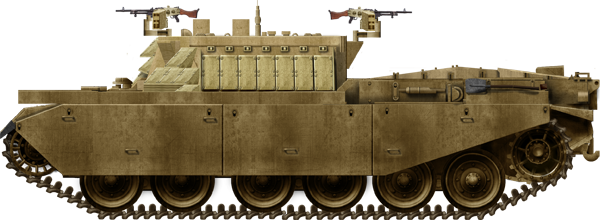
Nagmasho't with a southern livery, 1985
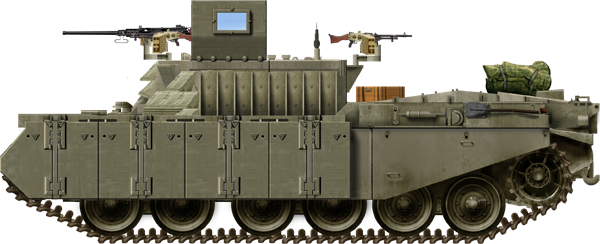
Test vehicle for the development of the Nagmachon, 1988.
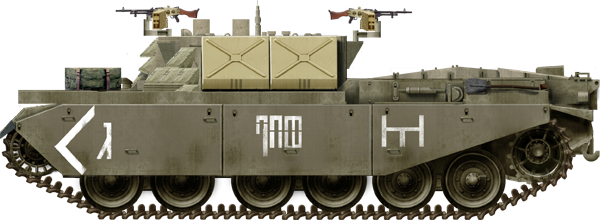
Nagmasho't from an engineering unit, 1997
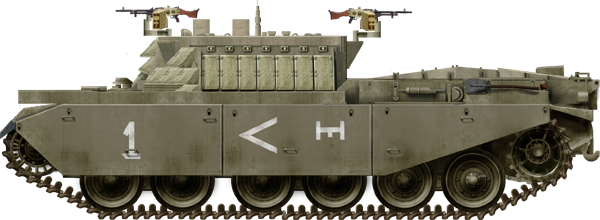
Nagmasho't of an engineering unit, Lebanon 1999


Links
militarytoday.comisraeli-weapons.com/
tanknutdave.com
armedconflicts.com
britmodeller.com
tsahal-miniature.com
weaponews.com/
acemodel.com.ua
Videos

Cold War Tanks


































Cold war tanks posters

Cold War Main Battle Tanks

Cold War Soviet Army
Museums, Movies, Books & Games
The Tanks and Armor in pop culture
Tanks and armored vehicles in general are only really grasped when seen first person: The mass, the scale, it's all there. Explore also the way tanks were covered in the movie industry, in books and in video games.Movies:
Best tanks movie on warhistoryonline.com
On imdb.com
On bestsimilar.com/
miltours.com
liveabout.com/
watchmojo.com
Video Games:
pcgamesn.com
historyhit.com
levvvel.com
vg247.com/best-tank-games
mmobomb.com/
alienwarearena.com

